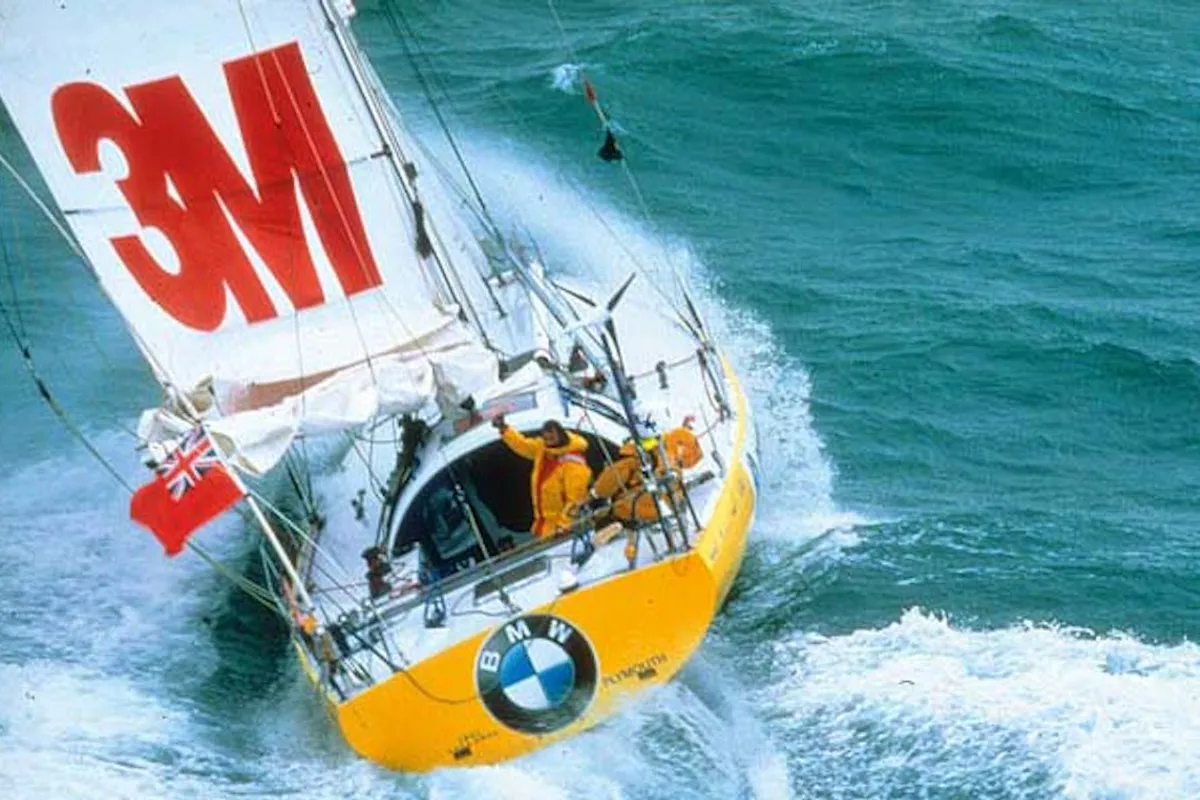Photo shows: Pete Goss on Aqua Qurum (50ft) in the 1996 Vendée Globle - Pete became the first sailor to complete a circumnavigation on a boat with a canting keel.
As the list of enquiries received about the Global Solo Challenge 2023 tops 220 sailors (of which more than 150 already own a boat) organisers need to ensure the event remains fair, even in light of a potentially diverse fleet at the start.
17 skipper have already confirmed their entries. At the lower and slower end of the scale, we have now received 10 enquiries from 32 footers, the minimum length allowed by the Notice of Event.
At the upper end of the scale, 4 Open 50s of the former IMOCA 50 Class have made provisional enquiries. These boats are within the maximum allowed length by the Event of 55ft, however, their expected performance and circumnavigation time is out of the scale currently envisaged by the entry criteria.
The tortoise and the hare
The Global Solo Challenge, with its unique format of staggered starts, is set to be a sailing re-enactment of the tale of the tortoise and the hare. Slow boats depart first chased by the faster boats which set off later. Once at sea there are no classes and the first boat home wins.
The expected circumnavigation time for each boat determines the departure group. This requires complex simulations and comparisons with available reference times to keep the event fair.
A group for the small tortoises
We have had a total of 4 Contessa 32s owners writing in, we know their passage time will probably be over 200 days compared to the approximate 190-195 days predicted for a good boat in the current slowest group.
For this reason, we are evaluating the possibility of a further group that will allow these boats to set off a little earlier. We are still running simulations and looking at precedents. One enquiry is from a Contessa 32 which has already completed a single-handed circumnavigation in 2018.
Other boats that may benefit from this new group are small long keelers which would not keep up with more modernly designed boats.
A group for the hares of the oceans
There are only a handful of events that today accept an Open 50 as an entry. Examples are the Rhum Class of the Route du Rhum or the OSTAR. There aren't any around the world events open to these boats.
It is in keep with the spirit of the Global Solo Challenge to offer a departure for these boats, even more so if there are no other similar events they can attend.
Several simulations confirm that an up to date Open 50, with canting keel, weather routeing and modern sails allowed, should expect to complete the circumnavigation in about 115-120 days from La Coruña.
To keep the event fair these boats should set off approximately 3 weeks after an average first/second generation Class40 such as that sailed by Guo Chuan in 2013 (Akilaria RC2) when setting a reference time of 137 for a solo non stop circumnavigation on a 40ft boat. The course from La Coruña is slightly longer than that sailed by Guo Chuan and would therefore add a few days to the expected circumnavigation time for a similar boat.
Open 50s vs latest generation Class40s
A latest-generation Class40 with a large scow-type bow, in the hands of a capable skipper would probably perform in line with the estimated time of older IMOCA 50, such has been the incredible design improvement in recent years. These modern projects are typically built for the professional circuit of Class endorsed events and are unlikely to be interested in the Global Solo Challenge, which is more adventure oriented than aimed at professionals.
IMOCA 50 or Open 50 owners are encouraged to write in to express their interest in the GSC, to assist us deciding on this potential group which would certainly add to the excitement and hype around the event.
Global Solo Challenge: a unique format
The format is unlike any other round the world solo sailing event and will make it fair and exciting for the Skippers as well as easy and engaging for the public and sponsors to follow:
A wide range of boats can enter – 32 to 55 foot.
Boats will be grouped by performance characteristics and set off in successive departures over 8 weeks.
Once at sea, there are no classes. All boats will be sailing the same event. The faster boats will have to try to catch up with the slower boats, the pursuit factor creating competitive interest aboard and a fascinating event for the public and sponsors.
The first boat to cross the finish line wins. The performance differential between the boats is taken into account in staggering the departures, eliminating the need to calculate corrected times.
Global Solo Challenge - Course
All entries will have a chance of winning – dramatic from beginning to end
It will feel quite daunting and emotional to be among the first skippers to set off. Equally it will be nerve wracking for those with a long wait before their departure.
The last skippers to set off will have to keep cool waiting for their turn to start the chase.
The faster boats will need to sail fast and well to make up for the head start given to the slower groups.
It will be the ultimate enactment of the tale of the tortoise and the hare, with steady cruisers being chased by performance thirsty skippers on faster boats.
Who will cross the line first?
News & Image Source Global Solo Challenge
Click here for more news, images and video on the Global Solo Challenge website
